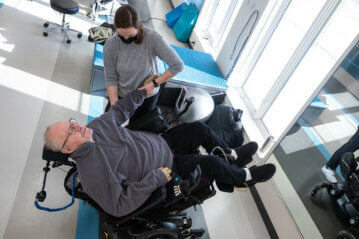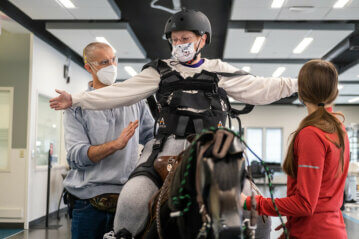Spinal cord injuries bring with them numerous questions as the road to recovery widens before someone. The very nature of them—the completeness or incompleteness that hovers over can become very overwhelming. And yet, there is a way to explain both the injury and what recovery entails.
Functions of the Spinal Cord
The spinal cord is the link between the brain and the body, acting like a super-highway of information. It receives information from the body that it delivers to the brain for us to make sense of (sensory information), and it takes information from our brain out to our body (movement information). While the former is immediately understandable, the latter is just as important. The nervous system aspects of the spinal cord include “sensory” (pain, touch, and temperature) and other “automatic” (digestion, urination, heart rate, etc.) functions.
If a trauma or other damage comes to the spinal cord, many of these duties could be permanently altered.
How an SCI Occurs
There are many different ways a spinal cord injury can occur. Most can be considered traumatic—a forceful injury that directly damages or fractures the spine vertebrae. A car accident, gunshot, or fall from
Classifying Spinal Cord Injuries
When classifying the individual vertebrae, each section is given a corresponding letter and number, with the number ascending as the respective section descends along the back: C1-C7 for cervical, T1-T12 for thoracic, L1-L5 for lumbar, and S1-S5 for sacral. Within the cervical section, the further “up” the column an injury occurs, the more severe it can be. C1-C2 injuries may often be fatal, while C6-C8 have a better chance of being incomplete, or at least able to gain back function and some mobility through rehabilitation. Thoracic and lumbar injuries, while less likely to impede the mobility of the hands, significantly impact the hips and legs, while sacral injuries usually incur minimal injury.
Complete or Incomplete
A complete spinal cord injury means that the paralysis is full and cannot be regained. An incomplete injury indicates a possibility that progress with the paralysis could be made. Of course, there are also 
What Recovery Programs Look Like
Recovery programs for spinal cord injury programs are unique, varying on a case-by-case basis. Physical therapist Anna Calgaard notes that the ideal window to maximize rehabilitation potential for clients is within two years following injury. Above all, the goal for any client in rehabilitation is to ensure greater quality of life upon discharge, along with reestablishing as much personal independence in daily tasks as possible. For clients with both complete and incomplete injuries, upper body strength building is vitally important. One of the most significant activities that are exemplified through this is building a routine for and practicing transfers—such as moving oneself from their chair into bed. This task focus can encompass parts of both a client’s occupational and physical therapy program.
Two core facets of recovery programs are gait and mobility training—such as simulated walking sessions in the Ekso (bionic support), or the Zero-G (a harness that, while attached to a track along the ceiling, supports variable amounts of the client’s weight). While some clients have complete injuries
For more information on QLI’s spinal cord injury program, click here.
Categories: Ekso, Gait Training, Neuroplasticity, Occupational Therapy, Physical Therapy, Spinal Cord Injury
